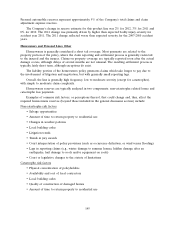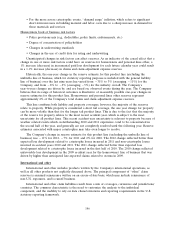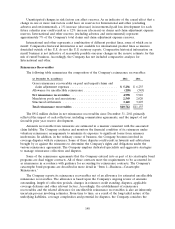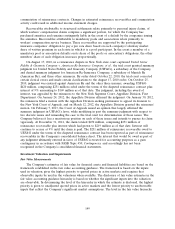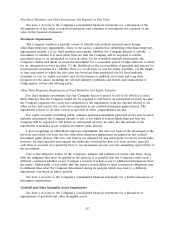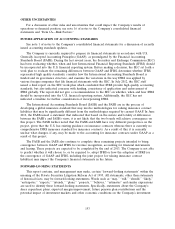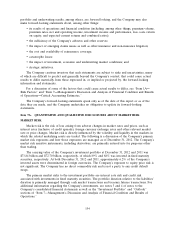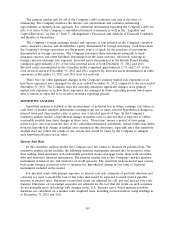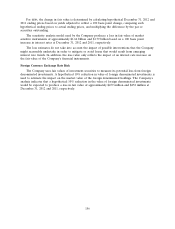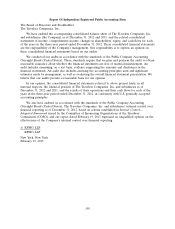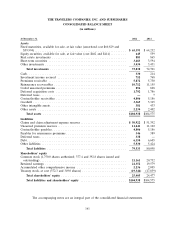Travelers 2012 Annual Report Download - page 165
Download and view the complete annual report
Please find page 165 of the 2012 Travelers annual report below. You can navigate through the pages in the report by either clicking on the pages listed below, or by using the keyword search tool below to find specific information within the annual report.OTHER UNCERTAINTIES
For a discussion of other risks and uncertainties that could impact the Company’s results of
operations or financial position, see note 16 of notes to the Company’s consolidated financial
statements and ‘‘Item 1A—Risk Factors.’’
FUTURE APPLICATION OF ACCOUNTING STANDARDS
See note 1 of notes to the Company’s consolidated financial statements for a discussion of recently
issued accounting standards updates.
The Company is currently required to prepare its financial statements in accordance with U.S.
Generally Accepted Accounting Principles (GAAP), as promulgated by the Financial Accounting
Standards Board (FASB). During the last several years, the Securities and Exchange Commission (SEC)
has been evaluating whether, when and how International Financial Reporting Standards (IFRS) should
be incorporated into the U.S. financial reporting system. Before making a decision, the SEC set forth a
work plan to evaluate the remaining differences between GAAP and IFRS, determine whether IFRS
represented high quality standards, consider how the International Accounting Standards Board is
funded and its governance structure, and examine the variations in the way IFRS was applied by
various foreign companies that file financial statements with the SEC. In July 2012, the SEC staff
issued a final report on the SEC work plan which concluded that IFRS provide high quality accounting
standards, but also indicated concerns with funding, consistency of application and enforcement of
IFRS globally. The report did not give a recommendation to the SEC on whether, when and how IFRS
should be incorporated into the U.S. financial reporting system. Additionally, the SEC has not
indicated a timeline for further consideration of incorporating IFRS.
The International Accounting Standards Board (IASB) and the FASB are in the process of
developing a global insurance standard that may involve methodologies for valuing insurance contract
liabilities that may be significantly different from the methodologies required by current GAAP. In June
2012, the FASB issued a statement that indicated that based on the nature and totality of differences
between the FASB’s and IASB’s views, it is not likely that the two boards will achieve convergence on
this project. The FASB further noted that the FASB and IASB have very different perspectives on the
project, given that the U.S. has existing guidance on insurance contracts whereas there is currently no
comprehensive IFRS insurance standard for insurance contracts. As a result of this, it is currently
unclear what changes, if any, may be made to the accounting for insurance contracts under GAAP as a
result of this project.
The FASB and the IASB also continue to complete three remaining projects intended to bring
convergence between GAAP and IFRS for revenue recognition, accounting for financial instruments
and leasing. These projects are expected to be completed by the end of 2013. The Company is not able
to predict whether it will choose to, or be required to, adopt IFRS or how the adoption of IFRS (or
the convergence of GAAP and IFRS, including the joint project for valuing insurance contract
liabilities) may impact the Company’s financial statements in the future.
FORWARD-LOOKING STATEMENTS
This report contains, and management may make, certain ‘‘forward-looking statements’’ within the
meaning of the Private Securities Litigation Reform Act of 1995. All statements, other than statements
of historical facts, may be forward-looking statements. Words such as ‘‘may,’’ ‘‘will,’’ ‘‘should,’’ ‘‘likely,’’
‘‘anticipates,’’ ‘‘expects,’’ ‘‘intends,’’ ‘‘plans,’’ ‘‘projects,’’ ‘‘believes,’’ ‘‘estimates’’ and similar expressions
are used to identify these forward-looking statements. Specifically, statements about the Company’s
share repurchase plans, expected margin improvement, future pension plan contributions and the
potential impact of investment markets and other economic conditions on the Company’s investment
153




